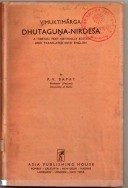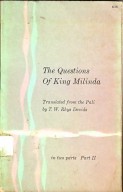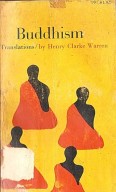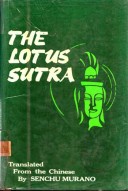Tìm Sách
Sách tiếng Anh-English >> Vituktimarga Dhutaguna – Nirdesa
Thông tin tra cứu
- Tên sách : Vituktimarga Dhutaguna – Nirdesa
- Tác giả : P.V. Bapat
- Dịch giả : P.V. Bapat
- Ngôn ngữ : Anh- Tibetan
- Số trang : 123
- Nhà xuất bản : Asia Publishing House - India
- Năm xuất bản : 1964
- Phân loại : Sách tiếng Anh-English
- MCB : 12010000004075
- OPAC :
- Tóm tắt :
VITUKTIMÃRGA
DHUTAGUNA – NIRDESA
A Tibetan text critically edited
And Translated into English
By P . V. BAPAT
Professor (Retired)
Universityof Delhi
ASIAPUBLISHING HOUSE
Bombay– Calcutta – New Delhi – Madras
Lucknow– London – New York
PREFACE
After nearly thirty years, I have been able to present to the world of scholars this Tibetan work: Rnam par grol bahi lam las sbyans pshi yon tan bstan pa: Vimuktimãgara-dhutaguna-nirdesa, in Roman and Nãgarĩ, characters, along with its English translation. Since difficulty has been experienced of securing Tibetan types in India, I had to take recourse to the use of Roman and Nãgari characters. In view of the difficulty experienced by orthodox Indian pandits, I thought of presenting the text in Nãgari characters also. I was encouraged in this direction by Pandit Rãhula Sãnkrtyãyana’s work Dohã-kosa, where he has used Nãgari letters throughout for the Tibetan version of the Dohãkosa. A scheme of transliteration adopted in my book for the Roman and Nãgarĩ versions will be found on page viii.
This work attracted my attention in 1932-33 and since then, off and on, I have been at it. Details about the same have been given, later, in the Introduction, topic 1-3. This text has been critically edited and is the result of the collation of the following material: -
A – Xylograph of Kanjur, Narthang edition. Preserved in the Theosophical Society’s Library at Adyar, Madras State.
B – A photostat copy of the text secured from the State Library of Berlin, Germany.
S – A manuscript copied in Shantinniketan, West Bengal, from a Xylograph of Kanjur, preserved in the Library of Vishvabhãratĩ, Shantiniketan, and West Bengal.
W1 – A photostat copy of the text (not expanded) from the Kanjur division preserved in the Library of Congress, Washington, U.S.A.
W2 – A photostat copy of another version (expanded) also preserved in the Library of Congress, Washington, U.S.A.
When most of the work on this text was already completed, a copy of the Lhasa edition of Kanjur became available to me in Delhi; but except for a few casual consultations, I could not use it for collation.
CONTENTS
DEDICATION
SCHEME OF TRANSLITERATION
CONTENTS
PREFACE
INTRODUCTON
TEXT AND TRANS LATION INTO ENGLISH
1. Aims and objects of the Practices of Purification
2. Thirteen qualities of Purification
3. The Meaning of the Thirteen Practices
4 The Practice of One who wears Dusty Rags (I)
5 The Practice of One who wears Three Garments [only] (II)
6 The Practice of One who lives on Alms (III)
7 The Practice of One who moves on for food in Succession (IV)
8 The Practice of One who has only one Sitting for his Food (V)
9 The Practice of One who takes measured Food (VI)
10 The Practice of One who takes no Extra Food after his meal (VII)
11 The Practice of One who lives in the Forest (VIII)
12 The Practice of One who lives in the vicinity of a Tree (IX)
13 The Practice of One who lives in the Open (X)
14 The Practice of One who lives in a Cemetery (XI)
15 The Practice of One who lives in Place as Found (XII)
16 The Practice of One who sits up (XIII)
17 Expediencies
18 Abridgement of the Thirteen Practices
19 Miscellaneous
20 Supplementary Questions
Glossary of Words: Tibetan-English (with the reference to the Text)
Appendix I: A Washington Manuscript (? Xylograph); photo-plates
Appendix II: Interpolations (? An intrusive passage) in the Fragmentary Tibetan version of the Vimuktimãrga
INDEX- GENERAL
INDEX OF PALI AND SANSKRIT WORKS
CORRECTIONS AND ADDITIONS
 Facebook
Facebook
 Google
Google
 Google+
Google+















